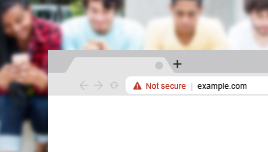In October 2016, Google announced a revolutionary plan to make the internet more secure through their main web browser, Google Chrome. The plan consists of three phases, the first of which was implemented in January 2017 when they started flagging HTTP websites containing a password and credit card field as “Not Secure.” The second phase began in October 2017 when Chrome started flagging websites with input fields and every website in incognito mode.
And in July of this year, the third phase will begin as Chrome plans to flag all HTTP websites without any exceptions. The tech giant confirmed in their latest blog post that they will indeed mark all unsecured websites as “not secure” on Google Chrome. This will be the culmination of Google’s information drive to advise website owners to upgrade the security of their websites with SSL Certificates and choose the safer HTTPS protocol.
Any website that doesn’t have a green address bar, a padlock icon, or a “secure” indicator on the address bar will automatically be flagged as untrustworthy. Chrome will start this new process with the release of Chrome 68 in July. "For the past several years, we've moved toward a more secure web by strongly advocating that sites adopt HTTPS encryption. And within the last year, we've also helped users understand that HTTP sites are not secure by gradually marking a larger subset of HTTP pages as 'not secure'," Chrome security product manager Emily Schechter wrote on the blog post. Most security experts agree on making the HTTPS protocol a standard for all websites.
HTTPS adoption made a huge progress last year. Over 68% of traffic in Google Chrome on Android and Windows is now protected, while 78% of traffic on Mac and Chrome OS is protected as well. By default, 81 out of 100 top websites on the internet uses HTTPS. Nonetheless, Google still wants to convert those who haven’t upgraded yet by employing several tactics, including SEO incentives for HTTPS websites.
Why should you switch to HTTPS?
Simply put, the HTTPS protocol will make your website a lot safer to transact with. Implementing HTTPS means encrypting the connection between a browser and a web server. A user can send any sensitive information to the web server and hackers won’t be able to intercept it because of this encryption. Your clients can now safely order an item or two on your online store and their credit card information won’t be compromised. All it takes is choosing the right SSL Certificate for your website.
A study in 2014 revealed that 73% of people online are aware of the numerous security risks when visiting a particular website while 77% are cautious about their personal information getting intercepted by hackers. Your clients can probably recognize whether your taking their safety seriously or not, so you better switch now before you lose your clients.
Encrypted websites also tend to be more responsive and have faster loading times. A quick look at this interactive website will reveal how superior a secured HTTPS website is compared to an unsecured HTTP website. By upgrading to HTTPS, you can give your clients a better surfing experience. The HTTP protocol can’t handle the intricacies of modern websites. They tend to load images and content at such a slow speed, your clients will probably think your company website is broken. That’s not really good for business.
Learn more about SSL Certificates by visiting our official website. You can also check out our free guide to help you get started on learning what SSL can do for your online security.







